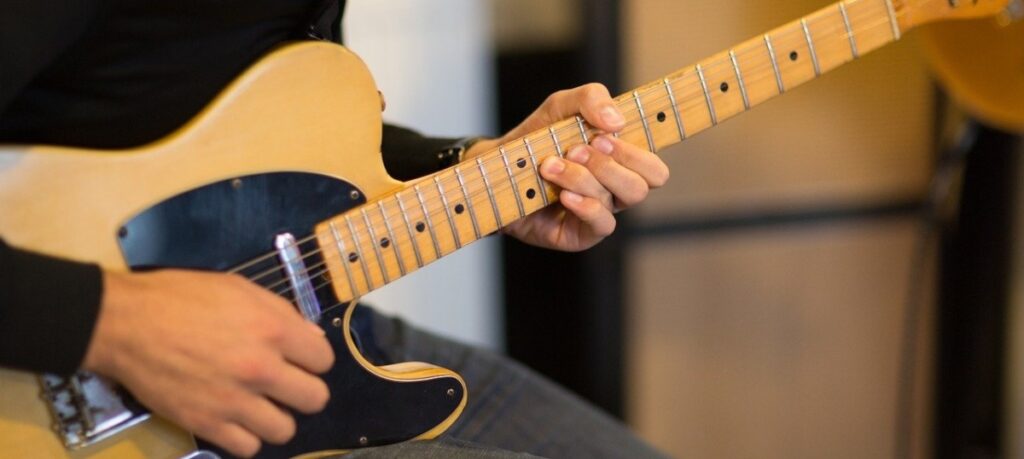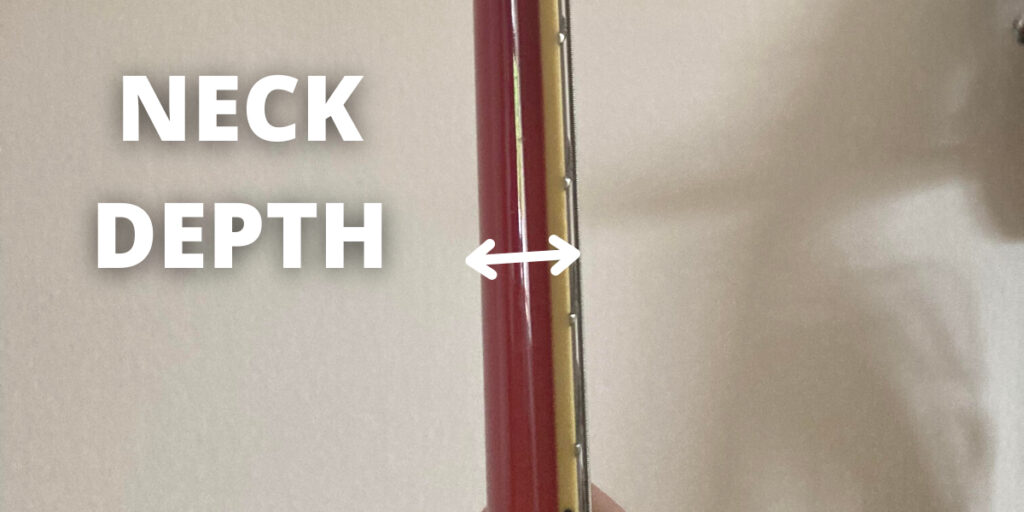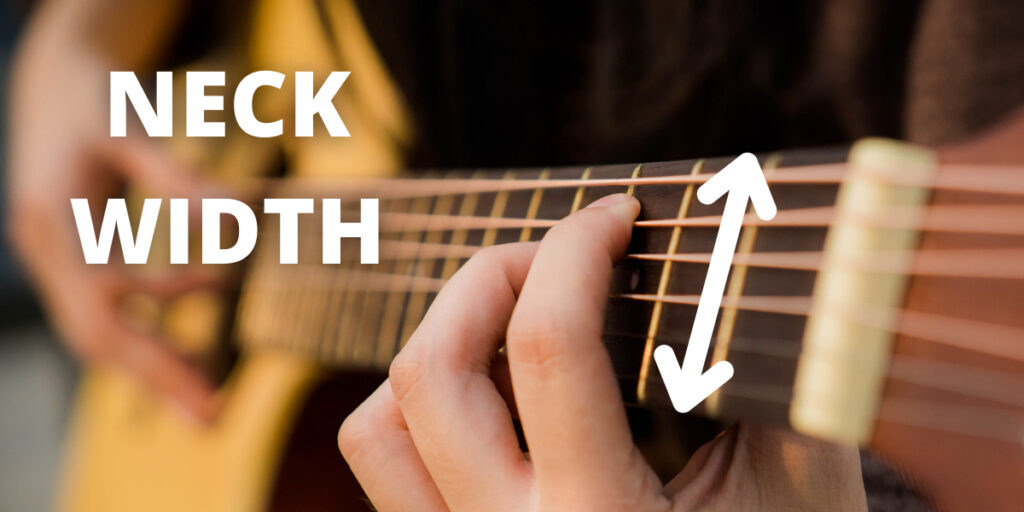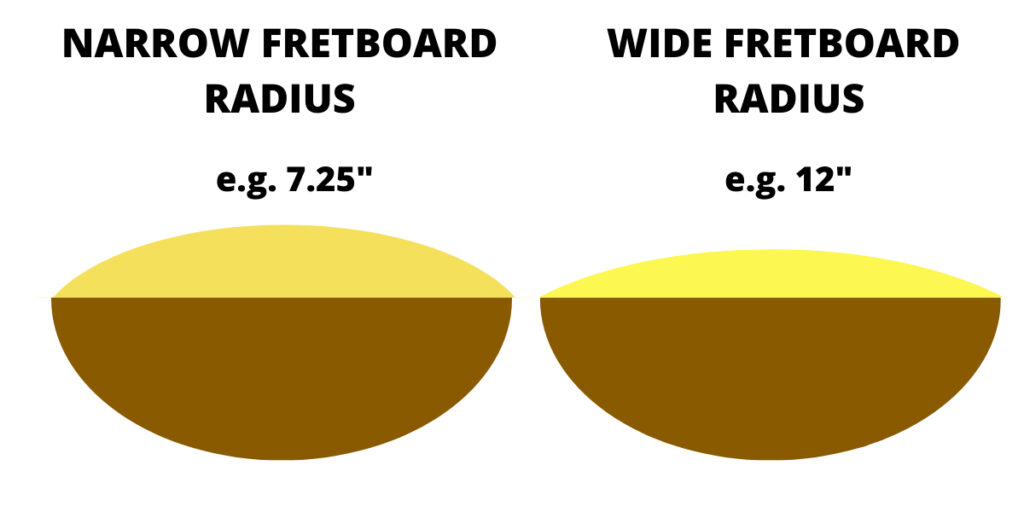If like myself, you have pretty small hands then you may need to be quite selective about the neck shape for your new guitar. In this article, I’ll explain what neck profiles and dimensions you need to look out for and provide a list of the best necks from major brands that suit small hands really well.
The Quick Answer
Most guitar players with smaller hands will prefer C and D shape necks with narrower fretboards and a shallow width. Necks with a larger fingerboard radius have a flatter fretboard and are often preferred by guitarists with smaller hands and fingers.
Guitars with thick-U shaped or hard-V shaped necks and narrow fretboard radiuses are often less suitable for players with small hands.
Ideal Neck Specifications/ Shapes for Guitarists with Small Hands:
- C or D profile
- Shallow neck width (ideally less than 0.85″ at the first fret)
- Moderate-large fretboard radius (at least 9″)
- Examples: Fender/ Squier Modern C and Modern D, Gibson Slim Taper/ Asymmetric Slim Taper
However, it’s very important to note that neck shapes are incredibly subjective. I have small hands and the neck shape that feels perfect for me, might actually feel horrible to you. It depends on your playing style and natural hand position as well as on the size of your palm and fingers.
I always recommend that you try some different neck profiles in a guitar store before settling on the best shape, as you may actually end up surprising yourself!

Neck Profile and Dimensions
There are four main measurements you should look at when considering the overall shape of the neck:
- Neck Profile
- Neck Depth
- Neck Width
- Fretboard Radius
Let’s discuss each specification individually.
Neck Profile
This is also commonly referred to as the neck shape, because it references the shape of the back of the neck. Different manufacturers use different nomenclature here, which can make things a bit confusing. However, there are 4 main profiles to consider:
- C
- D
- U
- V
If you were to cut a cross-section of the neck, it almost always closely matches the shape of one of the letters listed above.
It’s actually the profile that has a big impact on how the neck feels, not just the width and thickness of it. However some profiles typically lend themselves to being either on the thick or thin side. Different profiles feel more comfortable to some players than others and it is very much a personal preference.
It’s possible for one player with small hands to love a C shape neck and another much prefer a V shape neck. It’s something to consider as it massively affects how the guitar feels, but there isn’t a one-size-fits-all answer to which profile is best for players with smaller hands (pardon the pun).
| Profile | Description | Suitable for |
| C | Oval-shaped with curved shoulders | Most hand positions |
| U | Characterised by its very high shoulders. Variants include the “baseball” bat U-shape and the thinner shredder-style “U” | Players who rest their thumb on the back or side of the neck |
| D | Moderately high shoulders. Almost a cross between the U and C profiles | Most players especially shredders |
| V | Pointed shape. Variants include the soft-V and hard-V which refers to how dramatic the point it | Players who have their thumb over the top of the neck |
Not all manufactures use letters those to indicate the profile. For example, the Ibanez “Wizard” necks have a D-profile, so you may have to do a bit of digging if the profile isn’t stated so obviously.

Neck Depth
The depth of the neck refers to how thick the back of the neck is. The depth of the neck is also often technically incorrectly referred to as the “width”. Players with small hands will usually prefer a shallower neck as this means it’ll feel more manageable.
However, some players, even those with smaller hands despise super thin necks especially when playing chords because it can cause the hands to cramp. Very deep necks are often more suitable for lead players, shredders etc., that are playing on single strings.
Check out this list of electric guitars with the thinnest necks.
Hence, if you have small hands don’t automatically choose the thinnest neck going as it may not actually be the best option for your playing style. However, it’s a good rule of thumb to steer clear of “thick” necks as these will usually feel like a baseball bat.

Neck Width
The width of the neck refers to how wide the fretboard is at the nut. The width suitability will be more dependent on how long your fingers are rather than your palm, although there is still a relationship between the two measurements.
If you have very small hands, and short fingers then choosing a thinner width will be more suitable.
However, you don’t always have to choose a very narrow fretboard. It depends on the other parameters of the neck as well.
I personally have absolutely tiny hands and own a PRS with a “wide thin” neck. This means the neck is shallow so I can reach around it without any trouble, and the fact that it has a wider fretboard doesn’t impact my playing. Again, it’s a personal preference thing and will depend on your playing style and hand position.

Fingerboard Radius
The fingerboard radius refers to how curved the fretboard is. The smaller the radius, the more curved the fretboard will be. Most guitars have a fretboard radius between 9″ and 12.5″, however there are extremes. For example, vintage Fender guitars had a 7.25″ radius, whilst some shredder style guitars have a 16″ radius.
In general, players with smaller hands will prefer a flatter fretboard, and hence a larger fingerboard radius.
However, it does depend on your playing style as well. If you often play chords, then having a more curved fretboard may feel more comfortable. On the other hand, shredders often prefer a very flat fretboard. Some brands also have “compound” radius fretboards, so they are more curved near the nut where you typically play chords and flatter at the upper register for faster single-note playing.
Check out my article comparing fretboard radiuses to learn more about this topic.

Best Fender and Squier Guitar Necks for Small Hands
Fender and Squier have a range of neck shapes on offer and they cater very well for smaller hands. Most modern guitars have a 9-12″ fretboard radius which is fairly moderate and shouldn’t cause any issues. The necks are also relatively thin compared to other brands, and they don’t have very wide fretboards either.
Most modern Fender and Squier models have a modern C or D shape neck which feels quite thin and is regarded as comfortable for most players regardless of hand size.
Here is a table showing the best Fender/ Squier neck shapes for smaller hands.
| Profile | Depth at the 1st Fret | Depth at the 12th Fret | Examples |
| Modern D | 0.81” | 0.87” | Fender American Ultra models |
| Modern C | 0.82” | 0.89” | Squier, Fender Player, Fender American Performer models |
| Deep C | 0.81” | 0.92” | Fender American Professional II models |
| ‘60s C | 0.82” | 0.97” | Fender Vintera ‘60s/ American Original ‘60s Telecaster |
Stay Away From…
If you are purchasing a Squier or Fender guitar and you have small hands then you’ll want to steer clear of the following:
- 1952 “U” e.g. Fender American Original ’50s Telecaster
- Early ’50s “U” e.g. Fender Vintera ’50s Telecaster
- Vintage fretboard radiuses e.g. 7.25″ (go for 9″ or above)
Best Gibson and Epiphone Guitar Necks for Small Hands
Gibson and Epiphone offer “asymmetric slim taper” and “slim taper” necks which are very good for players with smaller hands. The “slim taper” neck has a C-profile and moderate thickness with a 12″ fingerboard radius and hence a fairly flat fretboard. The “asymmetric slim taper” is even thinner and again has that 12″ fretboard radius.
Here is a table showing the best Gibson/ Epiphone neck shapes for smaller hands.
| Profile | Depth at the 1st Fret | Depth at the 12th Fret | Examples |
| Asymmetric Slim Taper | 0.80” | 0.86” | Gibson Les Paul/ SG Modern |
| Slim Taper | 0.83” | 0.94” | Gibson Les Paul ‘60s Standard/ Classic/ Studio |
Stay away from…
Some Gibson guitars have very thick necks that are typically only suitable for players with average or larger hands. It’s best to stay away from the following neck profiles:
- Vintage ’50s e.g. Gibson Les Paul ’50s Standard/ Special/ Junior
- Rounded e.g. Gibson Les Paul Tribute
Best PRS Guitar Necks for Small Hands
PRS offer two main neck shapes which are very good for small hands: wide thin and pattern thin. These are C-shape necks which are quite shallow and have a fairly flat fretboard (10″ radius) on most models.
The “pattern” and “wide fat” necks are a bit chunkier and may be less suitable for players with small hands. However, they aren’t super thick so some smaller-handed players may find them perfectly manageable.
| Neck Profile | Depth at 1st Fret | Examples |
| Wide Thin | 0.81” | SE Custom 24 |
| Pattern Thin | 0.83” | Core Custom 24 |
| Pattern, Wide Fat | 0.88” | Core McCarty |
Best Ibanez Necks for Small Hands
Ibanez are very well known for making super thin and flat necks which are designed for shredding. Their “Wizard” necks have a D-shape profile and are seen on most of their line-up. As well as being good for shredding, they suit players with smaller hands very well.
Just be a bit careful if you play more rhythm than lead, as some players can find them too thin that they cause their hand to cramp up when playing chords.
In the market for a new guitar? I’ve written a complete buyer’s guide for electric guitars which takes you through all the things you need to consider and a step-by-step method to narrowing down your selection and choosing the best option. Here is a link to the article.

Hello, Heather. I just wanted to tell you that I did a lot of research to find the right neck size/type for a guitar, and I appreciated that you are one of the few people that actually spoke of neck width in addition to depth. I truly appreciate you taking so much time to advise individuals with small hands. I believe I must have even smaller hands than you because, unfortunately, the guitars/necks you suggested are all far to large for me. ( The width of the Ibanez are fine, but the D depth does not work for me.)
If you address this topic in the future, may I suggest that for electric guitars you look into G&L ‘Built to Order’ guitars (not their custom shop). They build these guitars with the parts that they have ready on hand, you just get to decide which neck, frets, pickups, etc. I recently purchased an ASAT Classic with a Slim C neck, 1 5/8” nut, and stainless steel frets. G&L was Leo Fender’s last word on the Telecaster and Stratocaster, and they are outstanding guitars.
Additionally, VOLA guitars are superb Japanese built guitars that come with even thinner and more narrow necks than G&L. Outstanding guitars with some of the best value you will find anywhere. Check out their OZ RV TNC, $1399.
As for acoustic, take a look at Takamine. I recent purchased a TSP138C thin acoustic electric with a 41.9862 mm nut. Some of the thinnest/narrowest necks you will find anywhere.
Unless I go to their custom shops and pay thru the nose, there are no Fender, Gibson, PRS or Ibanez guitars suitable for my tiny hands. My father left me his 1956 Gibson ES-125. Nice guitar, but I can’t play it very well.
Again, Heather, thank you for the time you took to address this issue. I hope I may have introduced you to some things of which you were not aware. Best of luck in all your endeavors.
Gary
5’4” Retired Marine
Hi, thanks for all these precious infos regarding the guitar neck size for small hands. I have a PRS Zack Myers wih 10 in radius wide fat and very comfortable to play even if it looks big on first try.